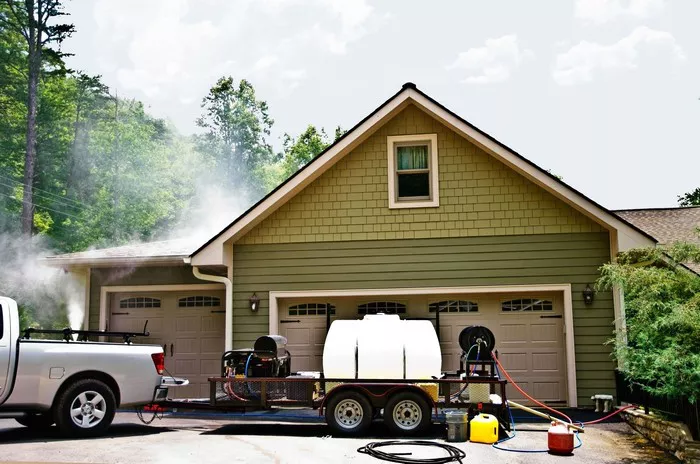Pressure washing is a vital maintenance task that helps keep your home looking fresh and prevents damage caused by dirt, grime, and mildew buildup. Determining how often to pressure wash your house depends on several factors, including your location, climate, and the type of siding you have. In this comprehensive guide, we will explore the recommended frequency for pressure washing various parts of your home to ensure optimal cleanliness and longevity.
See Also: How to Pressure Wash Your House in 9 Steps
Understanding the Benefits of Pressure Washing
Pressure washing offers numerous benefits beyond just aesthetic appeal. Here are some key advantages:
Enhanced Curb Appeal: A clean exterior enhances the overall appearance of your home, making it more inviting and appealing.
Preventative Maintenance: Regular washing removes contaminants that can cause damage over time, extending the lifespan of your siding, decks, and other surfaces.
Health and Safety: Eliminating mold, mildew, and algae reduces health risks associated with these contaminants, particularly for individuals with allergies or respiratory issues.
Preserve Property Value: Regular maintenance, including pressure washing, helps maintain the value of your property by preventing costly repairs and preserving the integrity of exterior surfaces.
Factors Influencing Pressure Washing Frequency
Several factors determine how often you should schedule pressure washing for your home:
Climate: Regions with high humidity or frequent rain may require more frequent cleaning to prevent mold and mildew growth.
Surrounding Environment: Homes near trees or dusty roads accumulate dirt and debris faster and may need more frequent washing.
Type of Siding: Different siding materials (vinyl, wood, brick, stucco) have varying maintenance needs and may require different cleaning frequencies.
Personal Preference: Some homeowners prefer a pristine appearance year-round and may opt for more frequent cleanings.
Recommended Pressure Washing Schedule
To maintain a clean and well-kept home exterior, follow these general guidelines for pressure washing frequency:
Annual Pressure Washing: A thorough cleaning once a year is generally recommended for most homes. This helps remove accumulated dirt, grime, and pollutants that can damage surfaces over time.
Bi-annual Pressure Washing: Homes in moderate climates or with less exposure to dirt and pollutants may benefit from pressure washing every six months.
Seasonal Considerations: In areas with distinct seasons, consider washing in the spring to remove winter debris and in the fall to prepare for the colder months.
High Humidity Areas: Homes in humid climates or near bodies of water may need more frequent cleaning to combat mold and mildew growth.
Specific Areas to Pressure Wash
Different parts of your home require varying levels of attention when it comes to pressure washing. Here’s a breakdown by area:
Exterior Siding
Vinyl Siding: Once a year is typically sufficient, although homes in shaded or humid areas may benefit from bi-annual cleaning.
Wood Siding: Wooden surfaces are more delicate and should be cleaned gently. Depending on weather exposure, wood siding may need annual or bi-annual cleaning.
Brick and Stone: These materials are durable but can accumulate dirt. Annual cleaning helps maintain their appearance and longevity.
Decks and Patios
Wooden Decks: Annually, or bi-annually if heavily used or exposed to harsh weather.
Concrete or Stone Patios: Once a year to remove stains and grime.
Driveways and Walkways
Concrete: Bi-annual cleaning can help prevent buildup of dirt and oil stains.
Pavers or Brick: Annual cleaning to remove weeds, moss, and dirt.
Roof
Asphalt Shingles: Experts recommend caution with pressure washing roofs, as high-pressure water can damage shingles. Consider gentle cleaning methods or hire professionals.
Tips for Effective Pressure Washing
To ensure your pressure washing efforts are effective and safe, follow these tips:
Use the Right Equipment: Select a pressure washer with appropriate PSI (pounds per square inch) for the task and adjustable nozzles for different surfaces.
Test on a Small Area: Before starting, test the pressure washer on a small, inconspicuous area to gauge its effectiveness without causing damage.
Use Proper Technique: Hold the spray nozzle at an angle and keep it moving to avoid streaks or damage to the surface.
Safety Precautions: Wear protective gear such as goggles and gloves. Be cautious on ladders and slippery surfaces.
Consider Professional Help: For complex jobs or delicate surfaces, hiring a professional pressure washing service ensures thorough cleaning without risking damage.
Conclusion
Maintaining a clean exterior not only enhances the appearance of your home but also protects its structural integrity and value. By understanding the factors influencing pressure washing frequency and following recommended guidelines for different surfaces, you can ensure your home remains in top condition year-round. Whether you choose to tackle this task yourself or hire professionals, regular pressure washing is an investment that pays off in the long run by preserving your home’s beauty and durability.
Remember, the key to effective pressure washing lies in consistency and proper technique. By adhering to these principles, you can enjoy a clean, well-maintained home for years to come.
In conclusion, while the frequency of pressure washing your house varies based on several factors, the benefits of regular maintenance cannot be overstated. From enhancing curb appeal to preventing costly repairs, pressure washing is a simple yet effective way to protect your biggest investment—your home. By following the guidelines outlined in this article and tailoring them to your specific needs, you can ensure that your home’s exterior remains clean, attractive, and structurally sound throughout the seasons.

